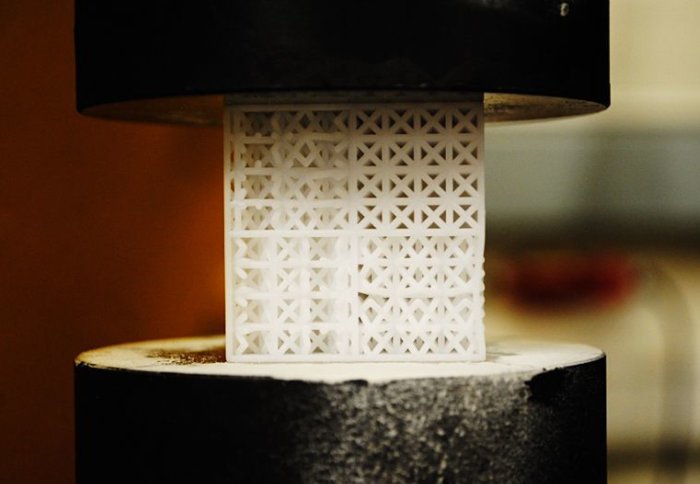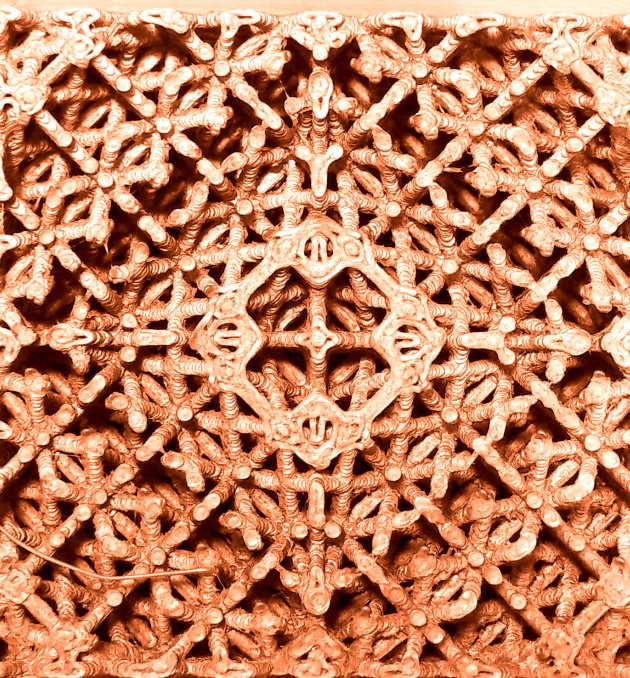3D printing and metals science combine for stronger, crystal-inspired materials

Imperial materials scientists have created new artificial materials which combine our knowledge of metals with 3D printing.
The findings could speed up the use of 3D printed materials in everything from construction and vehicles to medical devices.
3D printing is often used to produce engineering components. The printed components contain lattice structures – patterns of material laid out like a grid, with repeating nodes and connecting struts, which make them lightweight.
However, when traditional types of lattices fail and crack, they do so catastrophically, which limits their use. Researchers suspect that this is because there is only one pattern of lattice throughout the material, and that varying the lattice structures inside could add strength.
"Now we can print robust materials, our method could be used in constructing vehicles and buildings, for example. Together with the combination of functional materials such as magnetic materials, the possibilities are endless." - Dr Pham, Department of Materials
Now, inspired by patterns in natural crystals, researchers from Imperial College London and colleagues at the University of Sheffield have introduced features into 3D-printed metals that mimic the structures in crystals, like grains. Lead author Dr Minh-Son Pham, from Imperial’s Department of Materials, said: “By mimicking crystals’ hardening mechanisms, we can substantially strengthen lattice materials produced by 3D printing.”
 They found that, when loaded with weight, the new material — which they dub a ‘meta-crystal’ — is far stronger and more damage-tolerant than conventional lattice materials. They also found that the strength of the meta-crystals can be increased by reducing the size of each grain-like lattice region within the structure.
They found that, when loaded with weight, the new material — which they dub a ‘meta-crystal’ — is far stronger and more damage-tolerant than conventional lattice materials. They also found that the strength of the meta-crystals can be increased by reducing the size of each grain-like lattice region within the structure.
Their findings, published in Nature, could lead to tougher, lightweight 3D-printed materials suitable for a variety of applications.
Imperfect perfection
Currently available 3D printed lattices have a single repeating pattern that mimics the structure of a metallic single crystal: the nodes in the lattice are equivalent to the atoms in the single crystal, and the struts are equivalent to the atomic bonds. In each of these structures, the atomic planes, or nodes, are all perfectly aligned.
In some applications, such as the high temperature end of a jet engine, single crystal materials are ideal because of their ability to withstand deformation at extreme temperatures. However, they may not be able to withstand mechanical force.
When the structure is put under pressure, and once the force is enough to cause permanent deformation, the lattice shears along defined planes, and a crack spreads throughout the material. With nothing to inhibit this shearing, the material collapses catastrophically. 
However, in the new materials, which have many grains of crystals, the alignment of the atomic planes is changed from grain to grain. In these materials, when a shear force is in one direction, a crack will slow down or stop when it meets a crystal whose atoms are aligned differently from the original crystal. Moreover, it is possible to introduce different patterns to strengthen the materials further to help slow cracks.
Dr Pham said: “Now we can print robust materials, our method could be used in constructing vehicles and buildings, for example. Together with the combination of functional materials such as magnetic materials, the possibilities are endless.”
This news story was adapted from press releases from the University of Sheffield and Nature.
This paper was funded by EPSRC and the Royal Academy of Engineering.
“Damage-tolerant architected materials inspired by crystal microstructure” by Minh-Son Pham, Chen Liu, Iain Todd & Jedsada Lertthanasarn, published 16 January 2019 in Nature.
Image credits: Minh-Son Pham/Imperial College London
Article supporters
Article text (excluding photos or graphics) © Imperial College London.
Photos and graphics subject to third party copyright used with permission or © Imperial College London.
Reporter
Caroline Brogan
Communications Division